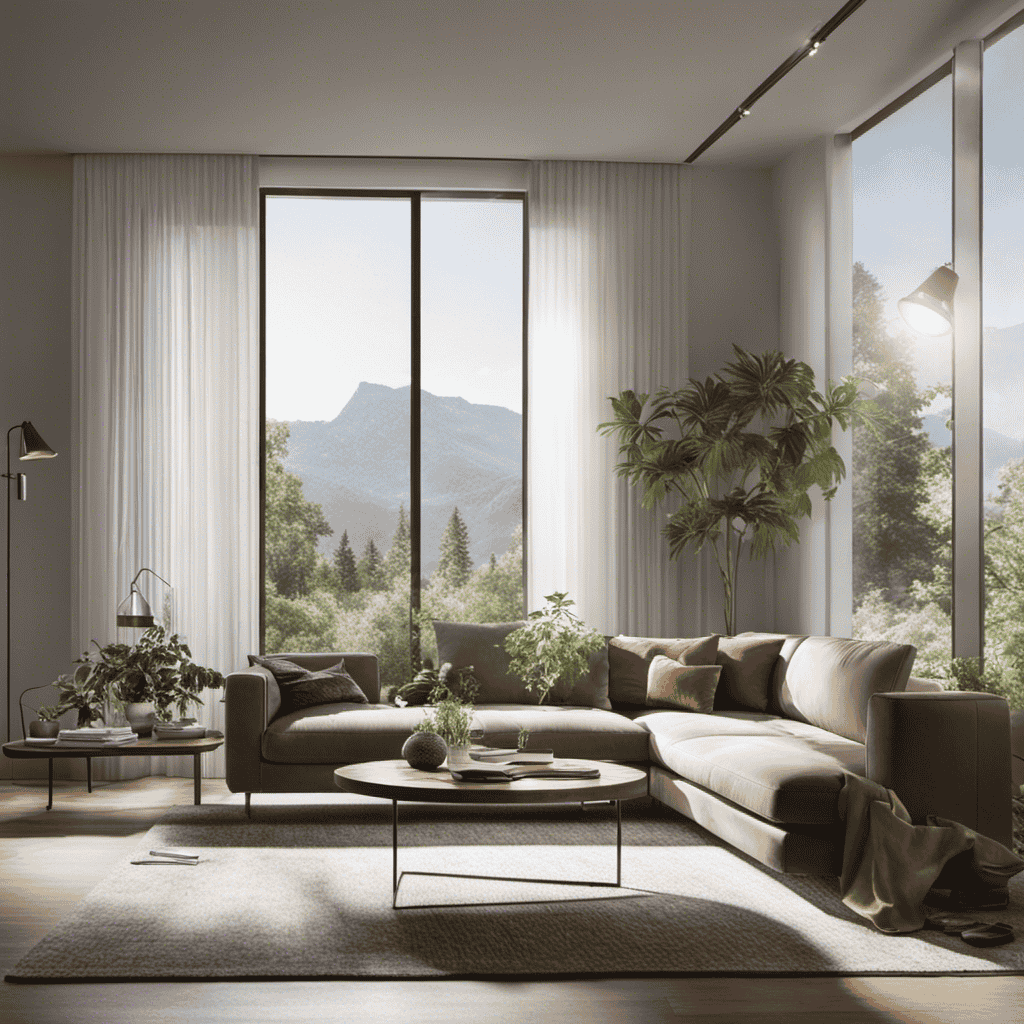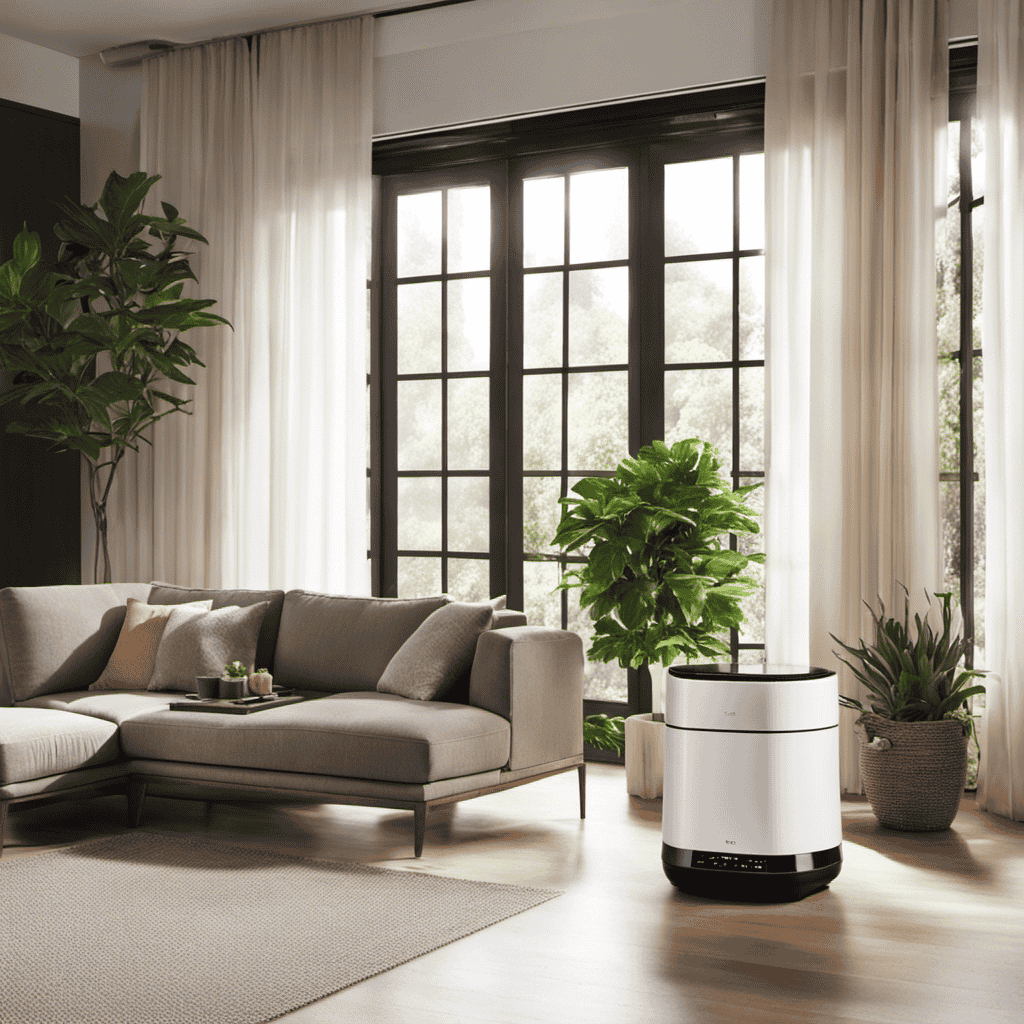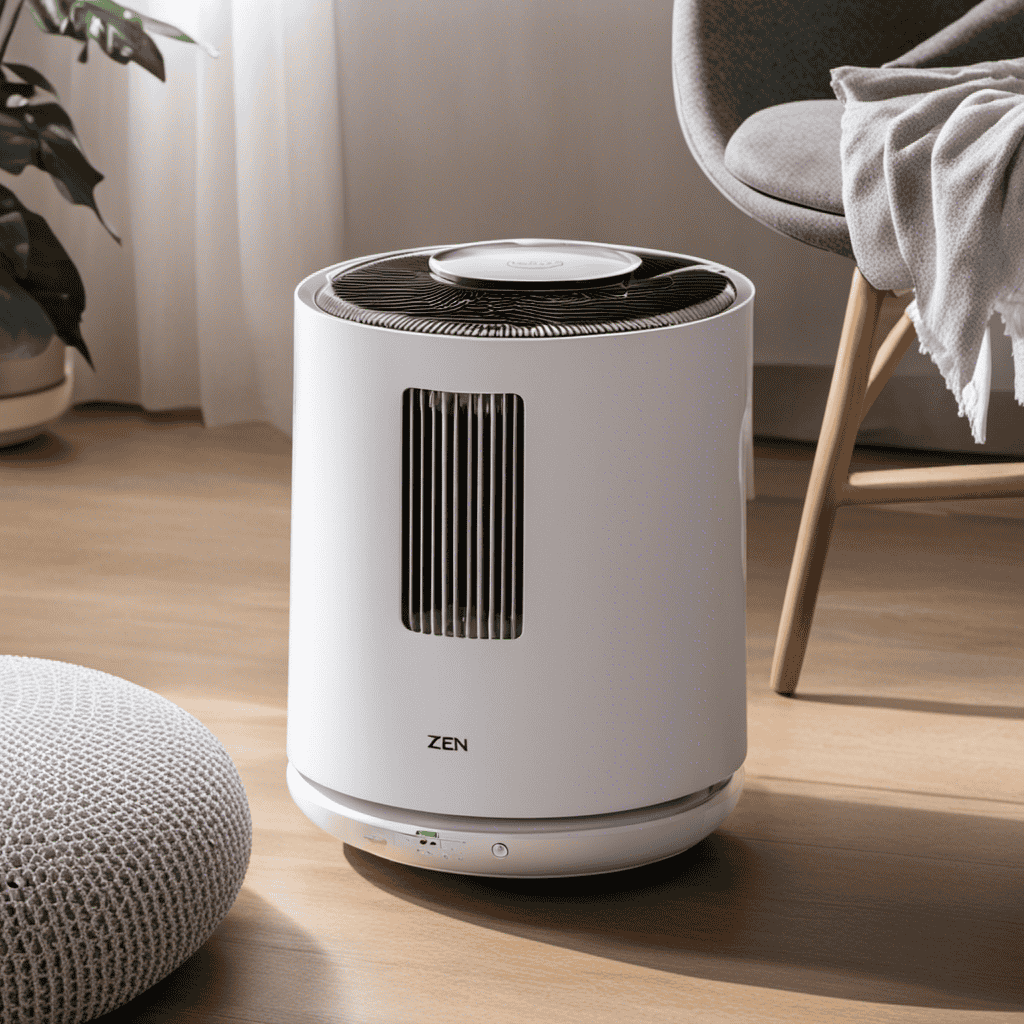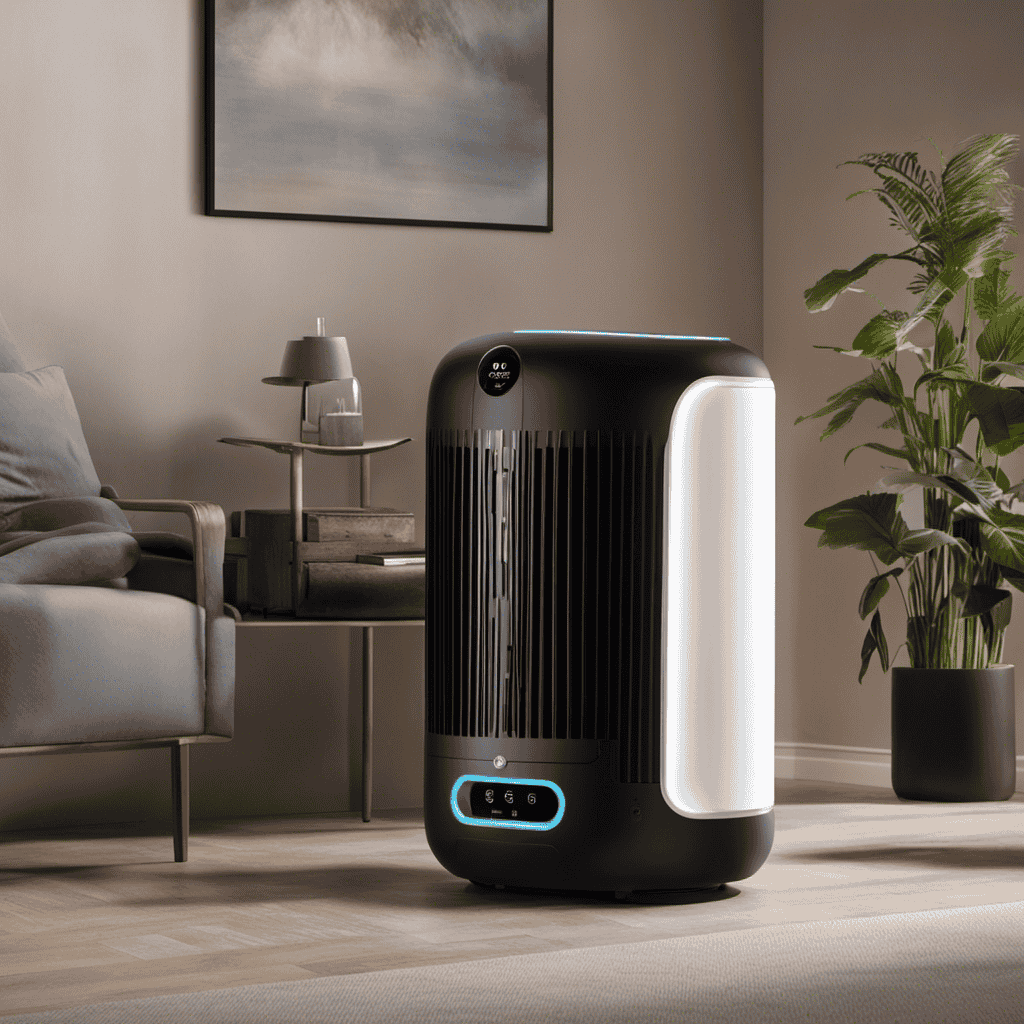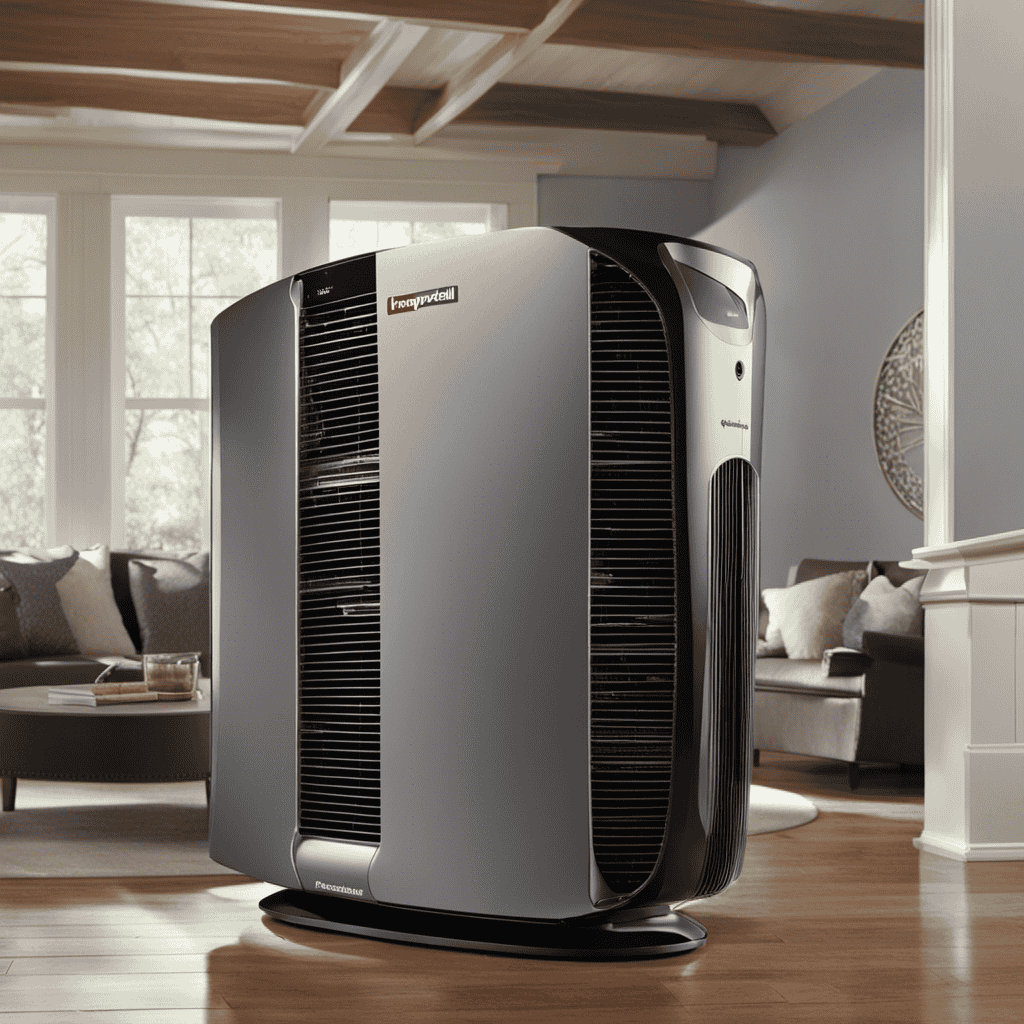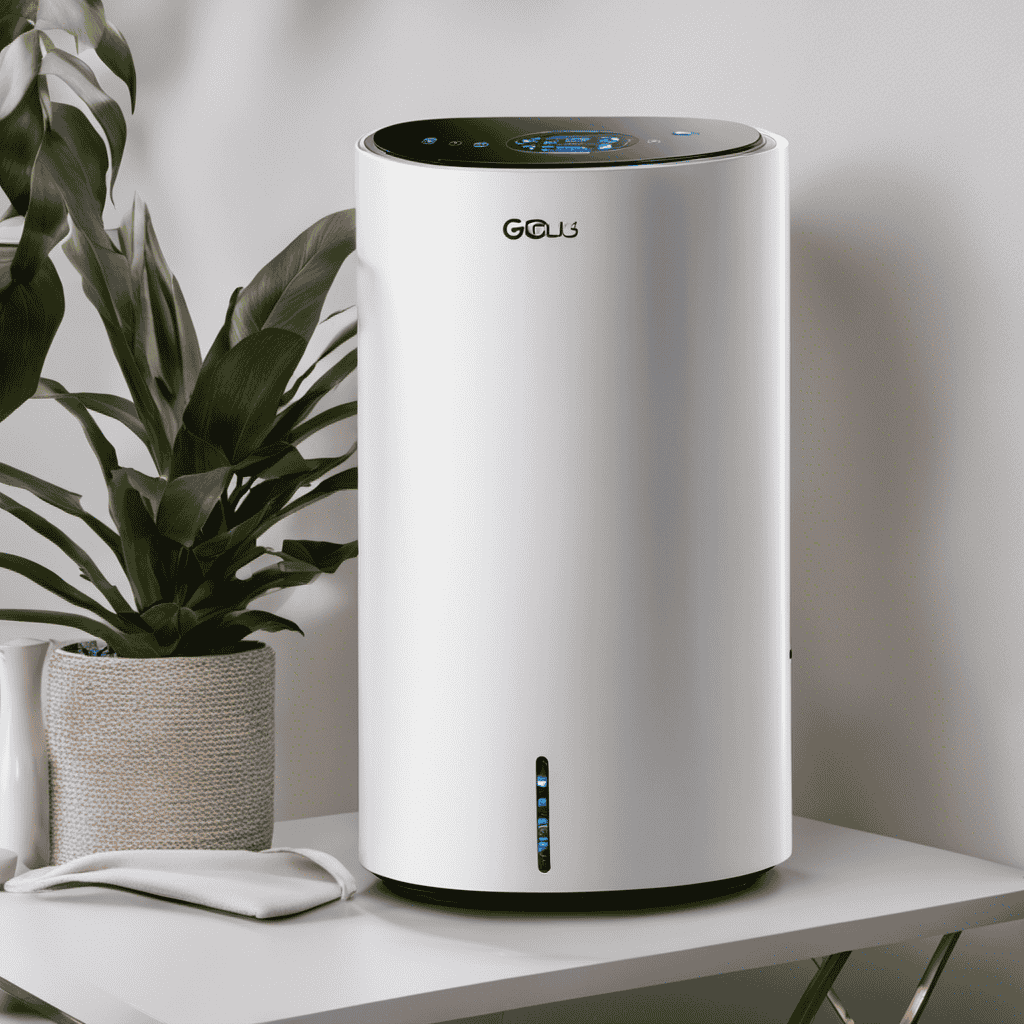I know you may be skeptical about another air purifier, but trust me, the UV air purifier is not like any other device out there.
With its advanced technology and powerful sterilizing capabilities, it goes beyond just filtering out pollutants.
In this article, I’ll explain the science behind UV air purifiers, how they work, and the numerous benefits they offer.
If you’re considering investing in one, you’ll also find helpful tips for choosing and maintaining your UV air purifier.
So, let’s dive in and discover what makes these purifiers so special.
Key Takeaways
- UV air purifiers use ultraviolet light to destroy airborne pathogens and microorganisms.
- UV-C light penetrates the cell walls of microorganisms, disrupting their DNA and preventing reproduction.
- UV air purifiers are highly effective in killing bacteria, viruses, and molds.
- Prolonged exposure to UV-C light can be harmful to humans and may cause skin and eye damage.
The Science Behind UV Air Purifiers
UV air purifiers use ultraviolet light to destroy airborne pathogens and microorganisms, helping to improve the overall air quality in your home. These purifiers are highly effective in eliminating harmful bacteria, viruses, and molds from the air, making them a popular choice for those concerned about maintaining a clean and healthy living environment.
The effectiveness of UV air purifiers lies in their ability to harness the power of ultraviolet light. Ultraviolet (UV) light, specifically in the UV-C range, has been proven to have germicidal properties. When UV-C light is emitted from the air purifier, it penetrates the cell walls of microorganisms, disrupting their DNA and preventing them from reproducing. This effectively neutralizes the pathogens, rendering them harmless.
However, it is important to note that while UV air purifiers are highly effective in killing microorganisms, they may not be as effective in removing other types of air pollutants, such as dust, pet dander, or allergens. Additionally, prolonged exposure to UV-C light can be harmful to humans and may cause skin and eye damage. Therefore, it is crucial to ensure that the UV air purifier is designed with proper safety features and that it is used according to the manufacturer’s instructions.
In the subsequent section, we will explore how UV air purifiers work in more detail, including the different types of UV technologies used and their specific mechanisms of action.
How UV Air Purifiers Work
To understand how UV air purifiers work, you’ll need to know about the technology used in these types of air purifiers. UV air purifiers utilize ultraviolet (UV) light to eliminate harmful particles and microorganisms from the air. UV-C light, specifically in the range of 200 to 280 nanometers, is highly effective in destroying the DNA and RNA of bacteria, viruses, and other pathogens. This process, known as germicidal irradiation, ensures the effectiveness of UV air purifiers in sanitizing the air.
UV air purifiers typically consist of a UV lamp, a reflector, and a filter. The UV lamp emits UV-C light, which is reflected by the reflector to maximize exposure to airborne contaminants. As the air passes through the purifier, the UV-C light kills or neutralizes harmful microorganisms. Some UV air purifiers also incorporate filters to capture larger particles, such as dust and allergens, enhancing the overall air purification process.
While UV air purifiers are highly effective in eliminating pathogens, it is important to consider potential risks. Prolonged exposure to UV-C light can be harmful to humans, causing skin and eye damage. Therefore, it is crucial to ensure that the purifier is designed to prevent direct exposure to UV-C light or that appropriate safety measures are in place.
Benefits of Using UV Air Purifiers
Using UV air purifiers can significantly improve indoor air quality by effectively eliminating harmful microorganisms. These devices utilize ultraviolet light to destroy bacteria, viruses, and mold spores, ensuring a healthier environment. Here are five reasons why UV air purifiers are a valuable addition to any space:
-
Enhanced respiratory health: UV air purifiers eliminate airborne contaminants, reducing the risk of respiratory infections and allergies.
-
Odor elimination: These purifiers can effectively neutralize unpleasant odors caused by bacteria and mold, leaving your space smelling fresh and clean.
-
Reduced spread of illnesses: By eliminating harmful microorganisms, UV air purifiers can help prevent the spread of illnesses such as the flu or common cold.
-
Low maintenance: UV air purifiers require minimal maintenance, making them a convenient and hassle-free option for maintaining clean air.
-
Cost-effective: Compared to other air purification methods, UV air purifiers are cost-effective options that provide long-term benefits without the need for frequent filter replacements.
Furthermore, UV air purifiers have a minimal impact on energy consumption. They operate using low-wattage UV lamps and do not require excessive power to effectively purify the air. This makes them an environmentally friendly choice, as they contribute to cleaner air without significantly increasing energy usage.
Factors to Consider When Choosing a UV Air Purifier
When choosing a UV air purifier, it’s important to consider factors such as cost, maintenance requirements, and energy efficiency.
UV air purifiers are designed to eliminate airborne contaminants by using ultraviolet (UV) light to destroy them at a molecular level.
One of the key factors to consider is energy consumption. UV air purifiers use UV lamps to emit UV-C light, which requires electricity to operate. It’s important to choose a model that has low energy consumption to minimize the impact on your electricity bill.
Additionally, consider the price range of the UV air purifier. Prices can vary depending on the brand and features of the unit. It’s essential to set a budget and find a model that suits your needs without breaking the bank.
Lastly, maintenance requirements should be taken into account. Some UV air purifiers require regular replacement of the UV lamps, filters, or other parts. Consider the cost and availability of these replacement parts when making your decision.
Tips for Maintaining Your UV Air Purifier
Remember to regularly clean the filters and replace the UV lamps to ensure optimal performance of your UV air purifier. Maintaining your UV air purifier is essential to ensure its effectiveness in cleaning the air in your home.
Here are some tips on how to properly clean and maintain your UV air purifier:
-
Check the filters: Regularly inspect the filters for any dust or debris buildup. Clean them by gently vacuuming or rinsing them with water. If the filters are damaged or worn out, replace them with new ones.
-
Clean the UV lamps: UV lamps are crucial for killing germs and bacteria in the air. Wipe the surface of the lamps with a soft cloth to remove any dirt or dust. If the lamps are not working properly or are damaged, replace them.
-
Clean the exterior: Dust and dirt can accumulate on the exterior of your UV air purifier. Wipe it down with a damp cloth to keep it clean and free from debris.
-
Inspect the fan: The fan plays a vital role in circulating the air. Regularly check the fan for any obstructions or blockages. Clean the fan blades with a soft brush or cloth to remove any dust or dirt.
-
Schedule professional maintenance: While regular cleaning is important, it’s also beneficial to have your UV air purifier professionally serviced. A technician can thoroughly inspect and clean the internal components, ensuring optimal performance and longevity.
What Are the Benefits of Using a UV Air Purifier?
The UV air purifier meaning is to eliminate harmful airborne particles and microorganisms. Its benefits include reducing allergies, eliminating mold and bacteria, and improving overall indoor air quality. With its ability to destroy pollutants at a molecular level, a UV air purifier meaningfully enhances health and well-being.
Frequently Asked Questions
Are UV Air Purifiers Safe to Use in Homes With Children and Pets?
Yes, UV air purifiers are generally safe to use in homes with children and pets. They are effective at eliminating harmful bacteria, viruses, and mold spores from the air.
While UV radiation can be harmful when directly exposed to skin and eyes, modern UV air purifiers are designed with safety features to prevent any harm. It is important to follow the manufacturer’s instructions and keep children and pets away from direct exposure to the UV light.
UV air purifiers have a long lifespan and can provide continuous air purification for your home.
Can UV Air Purifiers Effectively Remove Odors From the Air?
UV air purifiers are known for their effectiveness in removing odors from the air. They use ultraviolet light to neutralize and destroy the odor-causing molecules. This process is particularly effective against volatile organic compounds (VOCs) and other odor sources.
Compared to other types of air purifiers, UV air purifiers have the added benefit of targeting viruses, bacteria, and mold spores, making them a comprehensive solution for improving indoor air quality.
Do UV Air Purifiers Require Any Special Installation or Setup?
Special installation or setup requirements for UV air purifiers may vary depending on the specific model and brand. However, in general, most UV air purifiers can be easily installed and set up without the need for any special tools or professional assistance.
They usually come with user-friendly instructions and can be simply plugged into a power source. Some models may require occasional maintenance, such as replacing the UV bulbs, but this is typically a straightforward process.
How Long Does the UV Lamp in an Air Purifier Typically Last Before Needing Replacement?
The lifespan of a UV lamp in an air purifier typically varies depending on the model and usage, but it usually lasts between 9 to 12 months before needing replacement.
UV air purifiers are beneficial because they use ultraviolet light to kill or deactivate harmful microorganisms like bacteria, viruses, and mold spores. This helps improve indoor air quality and reduce the spread of airborne illnesses.
Regularly replacing the UV lamp ensures optimal performance and effectiveness of the air purifier.
Can UV Air Purifiers Eliminate Allergens Such as Pollen and Dust Mites From the Air?
UV air purifiers can effectively eliminate allergens like pollen and dust mites from the air. These purifiers work by using ultraviolet (UV) light to destroy the DNA of microorganisms, including allergens. When the air passes through the purifier, the UV light kills the allergens, rendering them harmless.
This process ensures that the air you breathe is free from these irritants. UV air purifiers are an excellent choice for those looking to improve indoor air quality and reduce allergic reactions caused by pollen and dust mites.
Conclusion
To sum it up, the UV air purifier is a remarkable device that harnesses the power of ultraviolet light to eliminate harmful pathogens from the air we breathe. By employing cutting-edge technology, this purifier ensures that your indoor environment remains clean and safe.
Its efficiency in removing germs and allergens is truly awe-inspiring. With a UV air purifier, you can breathe easy knowing that your air is being thoroughly cleansed.
So why settle for anything less when you can have the best?
